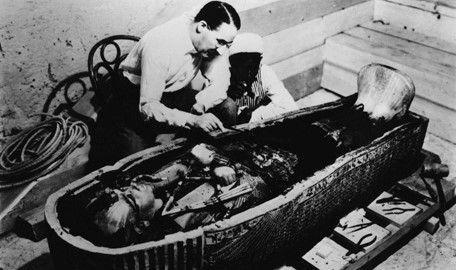On February 16, 1923, King Tutankhamen’s tomb was unsealed and entered by an excavation team led by British archaeologist Howard Carter and financial backer Lord Carnarvon.
Tomb Reveals Treasures
Howard Carter found the coveted mausoleum in Luxor, Egypt, in November 1922. But it was not until February 16, 1923, that the door was unsealed, revealing King Tut’s solid gold coffin and mummified remains.
According to the firsthand account of a member of Carter’s excavation team, published in The New York Times, it took hours of grueling work in the sweltering heat to move the tomb’s final door. Inside, the mummy was housed in “a spacious and beautifully decorated chamber completely occupied by an immense shrine covered with gold.”
Before it was opened, Carter made a small hole in the door and used a candle to see what seemed to be a “golden wall” blocking the King’s burial chamber. The sight was actually “an immense gilt shrine built to cover and protect the sarcophagus,” Carter wrote in his book “The Tomb of Tutankhamen.”
Though they might seem today to be treasures beyond imagining, the contents of King Tut’s tomb were modest by Pharaonic standards. In addition to jewelry and gold, Carter discovered a chariot, statuary and weapons.
The most stunning find was a stone sarcophagus containing three coffins nested within each other. Inside the final coffin, made of solid gold, was the mummified body of Tutankhamen, preserved for 3,200 years.
Valuable artifacts were removed from the tomb in the decade following Carter’s first entry, most of which are now housed at the Egyptian Museum in Cairo.
National Geographic provides an interactive look inside the tomb.
Sources in this Story
- The New York Times: Tutankhamen’s Inner Tomb is Opened Revealing Undreamed of Splendors, Still Untouched After 3,400 Years
- EyeWitness to History: Entering King Tut’s Tomb, 1923
- PBS: Egypt’s Golden Empire, New Kingdom – Tutankhamen
- National Geographic: King Tut Revealed
- Nature: King Tut’s death explained?
Biography: King Tutankhamen
Tutankhamen ruled Egypt from 1336 to 1327 B.C. His father Akenhaten left the 9-year-old heir with a country in ruins as a result of religious extremism.
The young king was originally named Tutankhaten, or “the living image of Aten,” after the sun god. While he was young, the military and priesthood used him as a puppet while they pushed a return to traditional ways and religion. As a result, they renamed him Tutankhamen, after Amen, a traditional god.
Tutankhamen died suddenly at the age of 19, and the circumstances of his death are still debated. A 1968 x-ray revealed loose bone fragments in Tut’s skull, which fueled speculation that he was murdered.
Recent scholarship has found that it is unlikely that Tut died of head trauma; the damage to the skull was more likely caused by the embalmers or by Carter’s excavators. Most scientific theories for Tut’s death focus on disease or infection.











